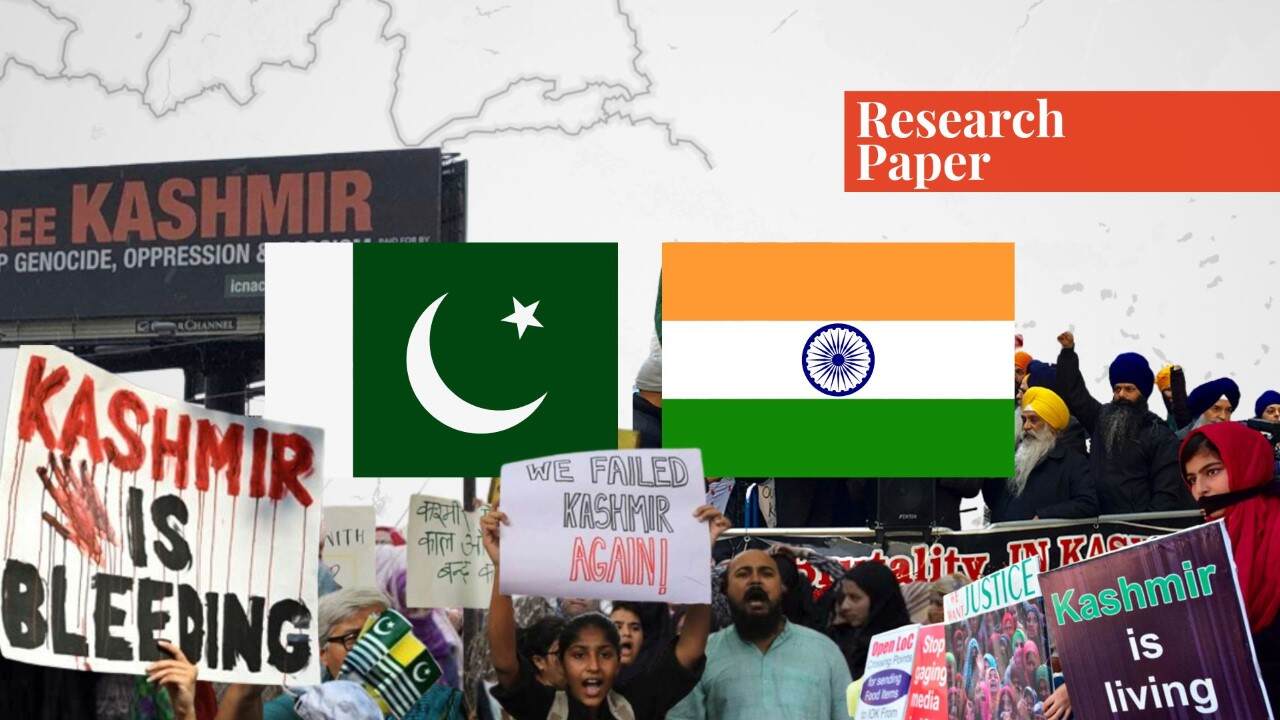Ms Brilliant Windy Khairunnisa is pursuing her Master's in International Relations and Diplomacy from Khazar University, Azerbaijan under the Nailakhanim scholarship.
Introduction
The position of the Kashmir region between Pakistan and India and the fact that the United Kingdom did not make a substantial decision regarding it before leaving are the primary causes of the conflict between the two nations. If they are owned, Kashmir’s natural resources could be considered extremely advantageous in abundant areas, including tourism and the economy.
The conflict between the two nations has gotten worse as a consequence of tensions between religions, particularly in Kashmir, where the bulk of the population is Muslim but the ruler is Hindu. Attempts to mend relations between the two nations were made once more in the presence of Donald Trump, the president of the United States, who volunteered to serve as a mediator.
India did not appreciate this attempt because it felt that if the United States acted as a mediator in the dispute over the Kashmir area, it would act in a biased manner and it would jeopardise India’s national interests (Gul & Ahmad, 2020). The pressure for peace has been widely carried out by several international parties. The rise of the globalisation age has had a discernible impact, making it increasingly unlikely that these issues will be resolved. However, conflict resolution could be much more readily carried out if technology in this period is utilised.
In the study of international relations, the theory of neorealism is inseparable from discussions related to conflicts, especially the Kashmir conflict that has occurred between Pakistan and India. Kenneth Waltz stated that the causes of war can be observed through several levels including individuals, countries and communities, as well as the international system.
Conflicts can occur due to the fact that basically all countries compete with each other to continue to survive and achieve their national interests. Neorealism also states that the powerful will continue to monopolise the world, while the weak will continue to be sidelined and become the prey of the strong. Thus, the Kashmir conflict will continue until the ultimate goal of the two countries is achieved.
Literature and Research
Due to globalisation, mediators face challenges in carrying out their duties (Khairunnisa, 2021). However, the underlying notion of nationality is losing its meaning as a result of globalisation, affecting people’s sense of nationality (Hippler & Ahmed, 2022). Due to competing national agendas, security programs might be confusing, inefficient, or futile, all at the same time. Domestic causes, according to this logic, are majorly responsible for the tension (Simón, 2017).
This study utilises descriptive qualitative research methods that can describe the results of research without statistics or figures. The data was provided through literature reviews of previous studies or papers, which are then reviewed and assisted by theories and concepts. Moreover, the triangulation approach has been utilised to examine the accuracy of the study data.
Commencing Point of the Kashmir Conflict
From a historical perspective, the struggle for the Kashmir region began when the British divided the Indian state into two parts, India with a majority Hindu population, and Pakistan with a majority Muslim population. Nevertheless, the division of the country left the ownership of the Kashmir region. Thus, this ownerless territory has led to the occurrence of conflicts (Rizvi, 2019).
The Kashmir region is affluent in natural resources and has a stable agricultural economy (Sheikh, 2018). Several rivers flow from the Kashmir region to Pakistan and India, which has made agricultural land in the two countries dependent on it (Tabbasum, 2012). Moreover, the natural beauty that is owned by the Kashmir region can attract a plethora of tourists to the international scene. Furthermore, the existence of the national interest concept has become critically important in issuing a foreign policy.
Neorealism and the Kashmir Conflict
Unlike realism, which believes that power is the ultimate objective that must be accomplished, neorealism believes that power is one of the means to fulfil a country’s national interest in terms of both security and survival. In other words, if a country collaborates with other countries, neorealism contends that the activity is only carried out to obtain benefits from other parties that benefit the country’s own.
Although it is frequently utilised to research interstate conflicts in other regions of the world, neorealism prefers to explain interstate conflict by concentrating more on the fundamental origins of interstate conflict than on individual disputes. Neorealism, therefore, anticipates that international limitations will restrict the options for nations.
Due to the fact that structural constraints have a widespread impact, neorealism seeks to explain general policies rather than specific policies in its view. The few incidents in terms of conflict are often limited to examples, therefore the neorealism approach is too uncertain to become a general theory of foreign policy or state behaviour.
Nevertheless, neorealism must be able to account for international outcomes, and this perspective expects states to be concerned about possible adversaries and seeks to balance them, even if such efforts are not always successful (Mehsud et al., 2021). This illustrates that neorealism emphasises the state as an actor in international politics, which tends to work with other countries to strengthen its power and achieve national interests (Napang et al., 2019).
According to neorealism, the major goal of the Kashmir conflict between Pakistan and India is to advance their respective national interests. The country that possesses the territory will observe significant growth in its GDP due to its natural resources. Its natural beauty can also draw tourists, boosting the economy in the tourism and hospitality sectors while attracting foreign investors to invest in the area.
Conclusion
In light of this evidence, it is crystal clear that neorealism dictates that the Kashmir conflict continues because both Pakistan and India desire to secure their national interests through this conflict. Neorealism also maintains that power is not the main objective; it is only a tool to gain national interest. In this case, Pakistan and India are fighting over Kashmir to gain its natural resources which could increase both countries’ GDP through trade and tourism.
As for the political aspect, the Kashmir region can expand the two nations’ territories and increase the number of Hindu adherents, which is of much interest to India. Nevertheless, conflict resolution must still be carried out because the people of Kashmir would suffer numerous losses as a result of this dispute.
References
- Ahmad Sheikh, Y. (2018). Implementation of rural development programmes in Jammu and Kashmir. Journal of Governance and Public Policy, 5(1). https://doi.org/10.18196/jgpp.5191
- Gul, A., & Ahmad, R. (2020). Critical Analysis of the Us Mediating Role in India-Pakistan Conflict. Margalla Papers, 23(02), 119–126.
- Hippler, J., & Ahmed, V. (2022). Global Pakistan: Pakistan’s Role in the International System. Friedrich Ebert Stiftung.
- Khairunnisa, B. W. (2021). The Role and Challenges of A Mediator To Resolve The International Conflict in The Digital Era ( Case Study : The Role of OANA ). Journal of Social Science, 2(5), 558–566. https://doi.org/https://doi.org/10.46799/jss.v2i5.199
- Mehsud, M. I., Jalal, I., Khan, T. A., & Jan, A. (2021). India-Pakistan Water Relations: A Theoretical Perspective. Pakistan Journal of Humanities and Social Sciences, 9(2), 158–166. https://doi.org/https://doi.org/10.52131/pjhss.2021.0902.0123
- Mukherjee, K. (2014). Comparing India’s Disputed Borderlands: Kashmir and the Northeast. In Jadavpur Journal of International Relations (Vol. 18, Issue 1). https://doi.org/10.1177/0973598414552749
- Napang, M., Nurhasanah, S., & Rohman, S. (2019). India-Pakistan Dispute on Kashmir: Pakistan’s Allegiance in the Efforts of “War on Terrorism” of the United States after the WTC 9/11 Attack. Journal of Terrorism Studies, 1(2), 26–36. https://doi.org/https://doi.org/10.7454/jts.v1i2.1009
- Rizvi, G. (2019). India, Pakistan, and the Kashmir Problem, 1947-1972. In Perspective on Kashmir: The Roots of Conflict in South Asia (1st Edition, p. 33). Routledge.
- Simón, L. (2017). Neorealism, Security Cooperation, and Europe’s Relative Gains Dilemma. Security Studies, 26(2), 185–212. https://doi.org/10.1080/09636412.2017.1280297
- Tabbasum, S. (2012). Water Adds to the Importance of Kashmir. Strategic Studies, 32, 186–199.
- Varshney, A. (2019). Three Compromised Nationalisms: Why Kashmir Has Been a Problem. In Perspective on Kashmir: The Roots of Conflict in South Asia (1st Edition, p. 44). Routledge.
If you want to submit your articles and/or research papers, please check the Submissions page.
The views and opinions expressed in this article/paper are the author’s own and do not necessarily reflect the editorial position of Paradigm Shift.



















